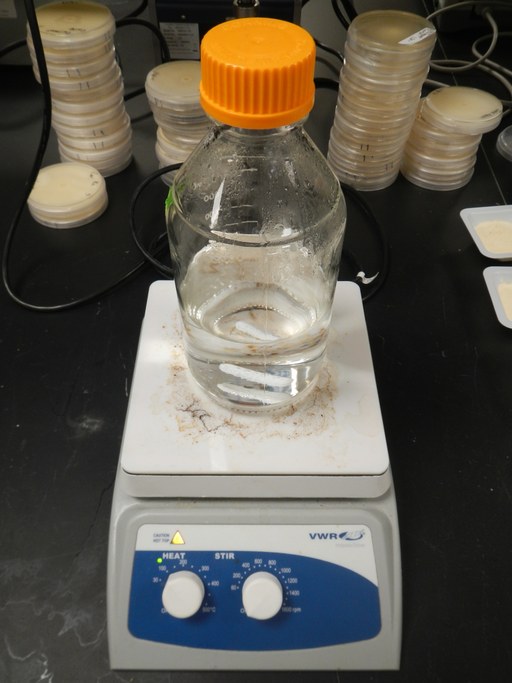
Measure 500ml de-ionized water in a graduated cylinder.

Pour 500ml de-ionized water from the graduated cylinder into a 1L glass jar and add a stir bar.

Place jar on a hot plat at 30C with the cap loosely on and heat until bottle shows condensation or is warm to the touch.

Using a weigh boat and scoop, weigh 19.5g potato dextrose agar. For water agar and bacteriological water agar, measure 10g bacto agar per 500mL. For bacteriological agar, also measure 0.25 g/500mL Penicilin G and 0.25g/500mL Streptomycin Sulfate to be used after media has been autoclaved.

Set magnet bar to about 600 or until the bar rapidly spins, creating a vortex.

Slowly add agar and mix until dissolved.

Screw the cap of the jar fully tight and then loosen one half turn. Add a piece of auto clave tape to the cap and place jar in a plastic container.

Place container in an autoclave and heat to 121C for 15 minutes.

Carefully remove container from the autoclave using gloves. Place jar in water bath and allow to cool.

While jars are cooling, sanitize the inside of the ventilation hood using Kim wipes and 70% ethanol.

Prepare petri plates to be poured by carefully removing the plastic sleeve they are in. Save the sleeve for later.

Use the key above and colored markers to label plates.

Once the agar is cool enough to hold, move a jar into the hood and remove the cap inside. Split plates into stacks of five. If you are making PDA or WA, you are ready to pour plates. If you are making AWA, place a hot plate with stirring capacity in the hood. Slowly add Penicilin G and Streptomycin and stir thoroughly before pouring plates.

Pour media into five petri plates leaving a clear pathway for air flow. Gently shake plates to ensure media reaches all edges. Repeat until all media is poured (500ml makes 25 plates).

Place plastic sleeve back over plates and allow to cool overnight. Seal the plastic and place in refrigerator for later use.
